1998 CHEVROLET ASTRO heater
[x] Cancel search: heaterPage 85 of 414
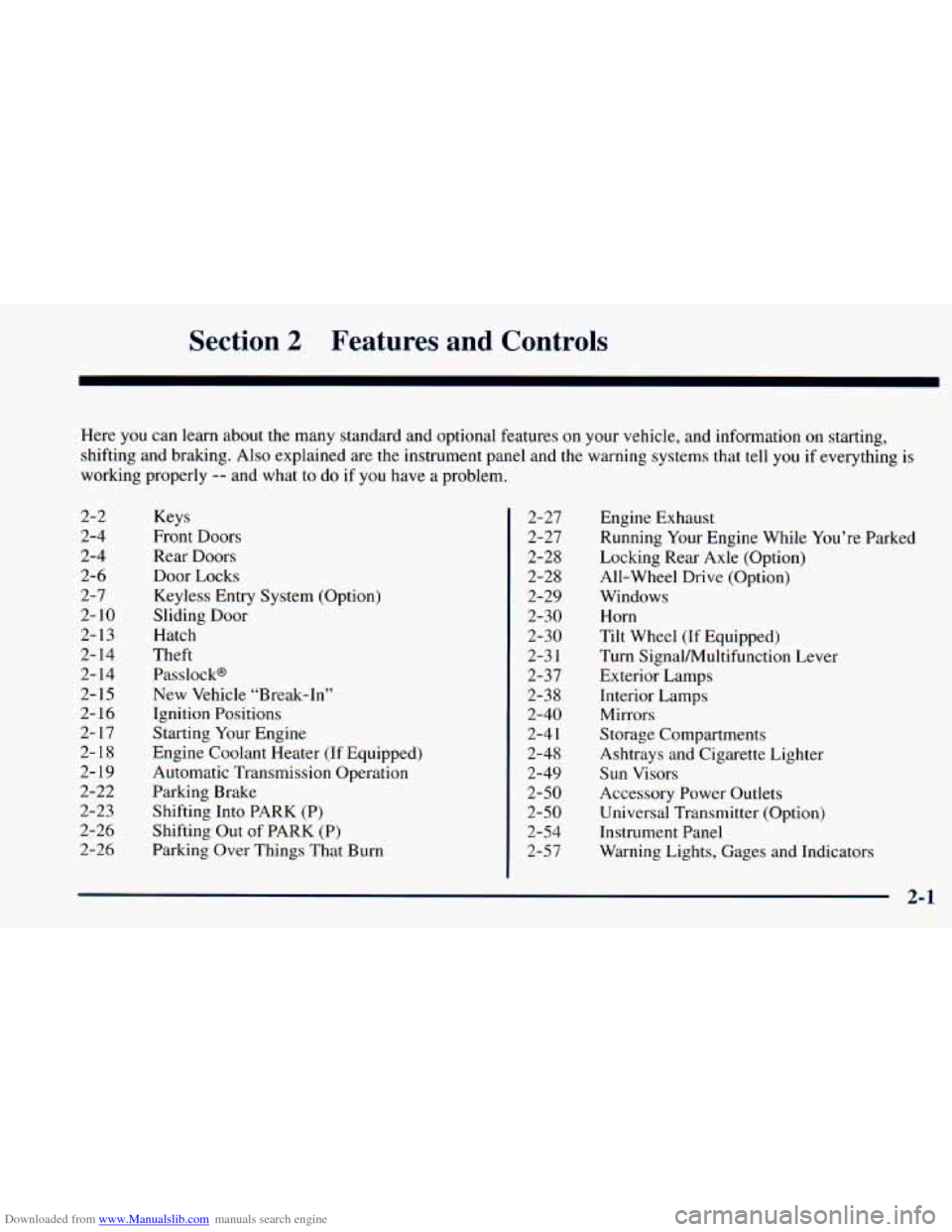
Downloaded from www.Manualslib.com manuals search engine Section 2 Features and Controls
Here you can learn about the many standard and optional features on your vehicle, and information on starting,
shifting and braking. Also explained are the instrument panel and the warning systems that
tell you if everything is
working properly
-- and what to do if you have a problem.
2-2 2-4
2-4
2-6
2-7
2-
10
2-13
2- 14
2- 14
2- 15
2- 16
2- 17
2- 18
2-
19
2-22
2-23
2-26
2-26 Keys
Front Doors
Rear Doors
Door Locks Keyless Entry System (Option)
Sliding Door
Hatch
Theft
Passlock@
New Vehicle “Break-In”
Ignition Positions
Starting Your Engine
Engine Coolant Heater
(If Equipped)
Automatic Transmission Operation
Parking Brake Shifting Into PARK (P)
Shifting Out of PARK (P)
Parking Over Things That Burn 2-27
2-
27
2-28
2-28
2-29
2-30 2-30
2-3
1
2-37
2-38
2-40
2-4
1
2-48
2-49
2-50
2-50 2-54
2-57 Engine Exhaust
Running
Your Engine While You’re Parked
Locking Rear Axle (Option)
All-Wheel Drive (Option)
Windows
Horn
Tilt Wheel (If Equipped)
Turn SignalhAultifunction Lever
Exterior Lamps
Interior Lamps
Mirrors
Storage Compartments
Ashtrays and Cigarette Lighter
Sun Visors
Accessory Power Outlets
Universal Transmitter (Option)
Instrument Panel
Warning Lights, Gages and Indicators
Page 102 of 414

Downloaded from www.Manualslib.com manuals search engine 3. If your engine still won’t start (or starts but then
stops), wait
15 seconds and start over.
When the engine starts, let go
of the key and the
accelerator pedal.
I NOTICE:
Your engine is designed to work with the
electronics in your vehicle. If you add electrical
parts or accessories, you could change the way
the engine operates. Before adding electrical
equipment, check with your dealer. If you don’t,
your engine might not perform properly.
If you ever have to have your vehicle towed, see
the part
of this manual that tells how to do it
without damaging your vehicle. See “Towing
Your Vehicle” in the Index.
Fuel Regulator
You have a fuel regulator that shuts the fuel off when the
engine reaches
5,600 rpm.
Engine Coolant Heater (If Equipped)
In very cold weather,
0°F (-18°C) or colder,
the engine coolant heater
can help. You’ll get easier
starting and better
fuel
economy during engine
warm-up. Usually, the
coolant heater should
be
plugged in a minimum of
four hours prior to starting
your vehicle.
To Use the Engine Coolant Heater
1. Turn off the engine.
2. Open the hood and unwrap the electrical cord.
The engine coolant heater cord is located on the
driver’s side
of the engine compartment, near the
power steering fluid reservoir.
3. Plug it into a normal, grounded 110-volt AC outlet.
2-18
Page 103 of 414

Downloaded from www.Manualslib.com manuals search engine A CAUTION:
Plugging the cord iL-_ 1 an ungrounded outlet
could cause an electrical shock.
Also, the wrong
kind
of extension cord could overheat and cause
a fire. You could
be seriously injured. Plug the
cord into a properly grounded three-prong
110-volt
AC outlet. If the cord won’t reach, use a
heavy-duty three-prong extension cord rated
for
at least 15 amps.
4. Before starting the engine, be sure to unplug and
store the cord as it was before to keep it away from
moving engine parts.
If you don’t, it could
be damaged. How long should
you keep the coolant heater
plugged
in? The answer depends on
the outside temperature, the
kind of oil you have, and some other things. Instead of
trying to list everything here, we ask that you contact
your dealer in the area where
you’ll be parking your
vehicle. The dealer can give
you the best advice for that
particular area.
Automatic Transmission Operation
There are several different positions for your shift lever.
II II
PARK (P): This locks your rear wheels. It’s the best
position to use when you start your engine because your
vehicle can’t move easily.
2-19
Page 139 of 414
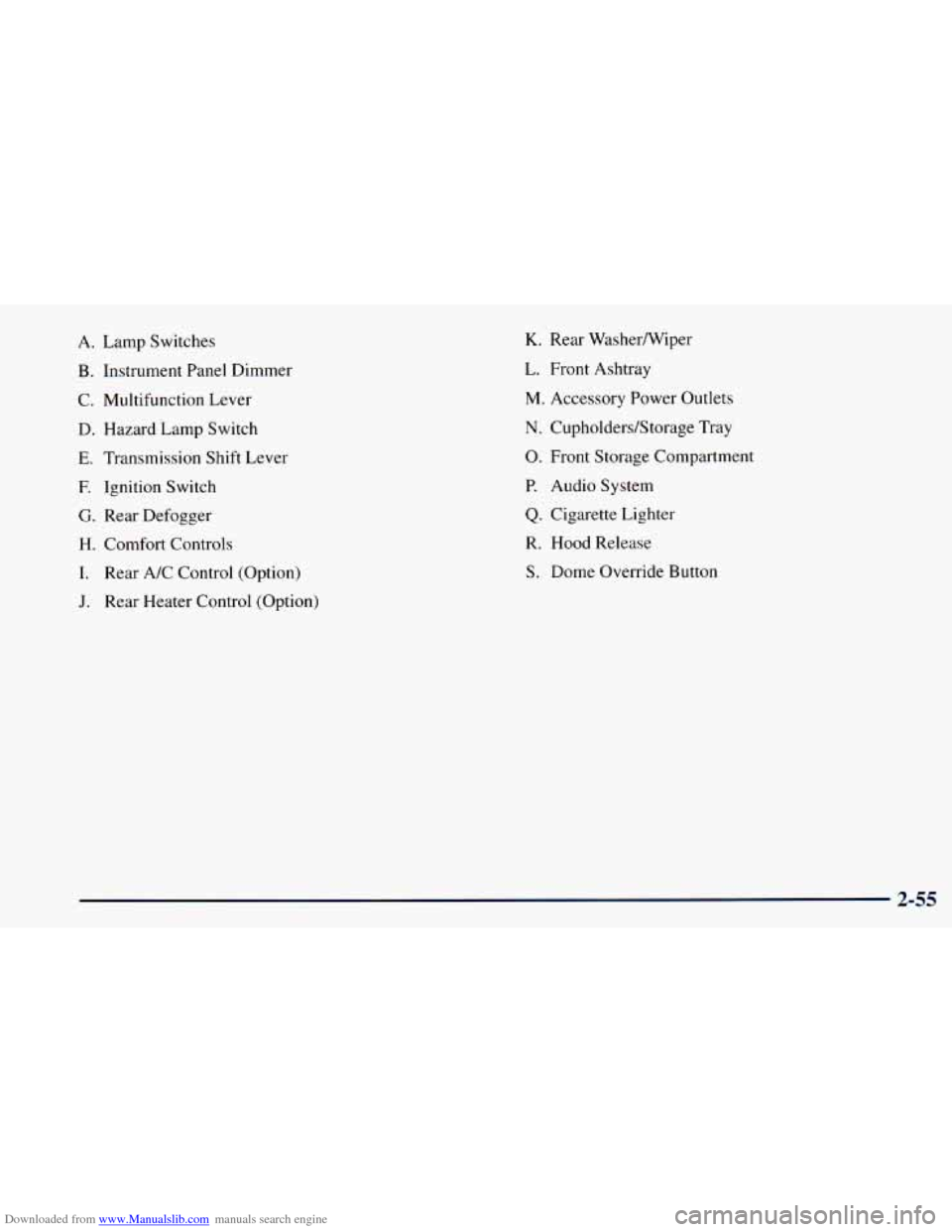
Downloaded from www.Manualslib.com manuals search engine A. Lamp Switches
B. Instrument Panel Dimmer
C. Multifunction Lever
D. Hazard Lamp Switch
E. Transmission Shift Lever
E Ignition Switch
G. Rear Defogger
H. Comfort Controls
I. Rear A/C Control (Option)
J. Rear Heater Control (Option)
K. Rear Washermiper
L. Front Ashtray
M. Accessory Power Outlets
N. Cupholders/Storage Tray
0. Front Storage Compartment
P. Audio System
Q. Cigarette Lighter
R. Hood Release
S. Dome Override Button
2-55
Page 155 of 414
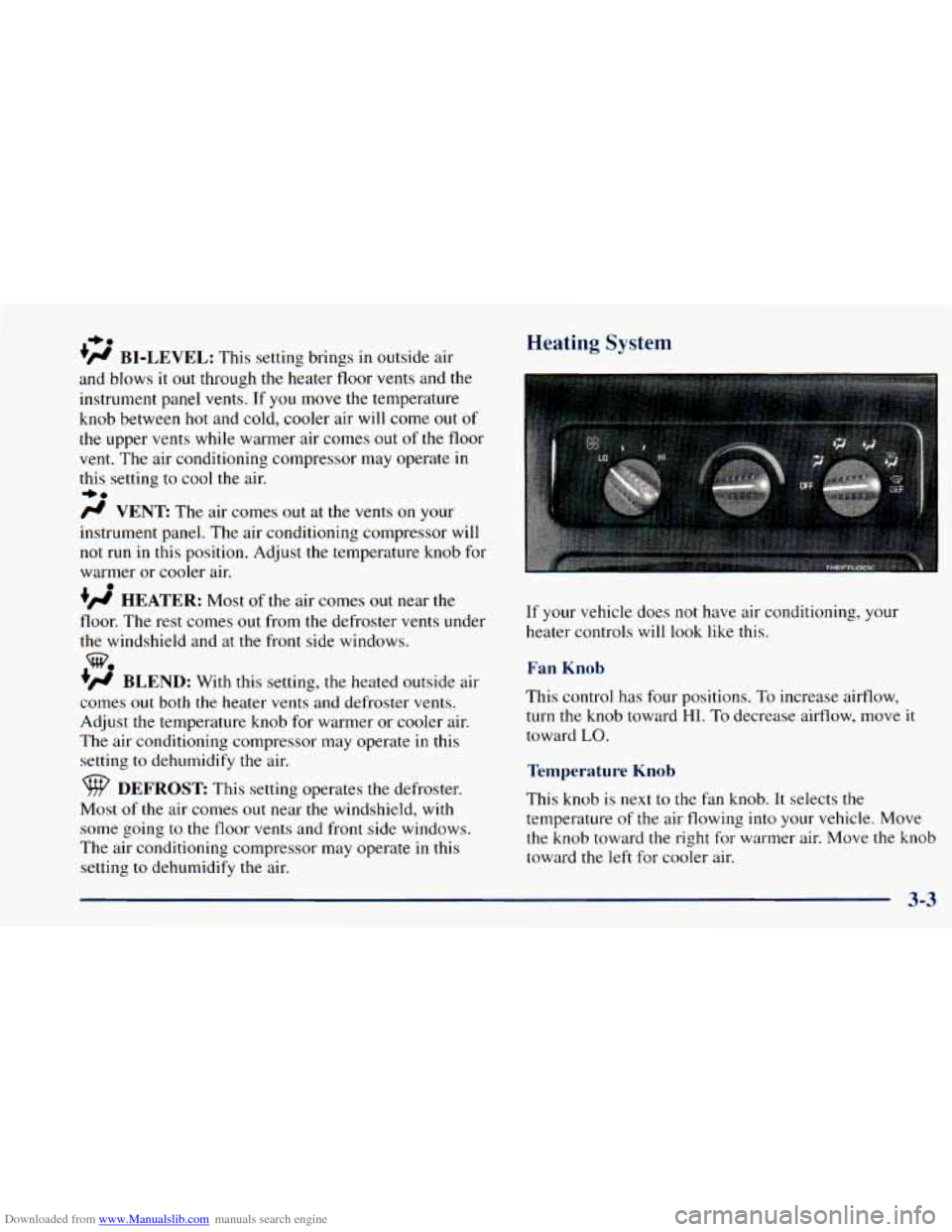
Downloaded from www.Manualslib.com manuals search engine -bo
+@ BI-LEVEL: This setting brings in outside air
and blows
it out through the heater floor vents and the
instrument panel
vents. If you move the temperature
knob between hot and cold, cooler air will come
out of
the upper vents while warmer air comes out of the floor
vent. The air conditioning compressor may operate in
this setting to cool the air.
/J VENT The air comes out at the vents on your
instrument panel. The air conditioning compressor will
not run in this position. Adjust the temperature knob for
warmer or cooler air.
+' HEATER: Most of the air comes out near the
floor. The rest comes
out from the defroster vents under
the windshield and at the front side windows.
+, BLEND: With this setting, the heated outside air
comes out both the heater vents and defroster vents.
Adjust the temperature knob for warmer or cooler air.
The air conditioning compressor may operate in this
setting
to dehumidify the air.
rl*.
0
w.
DEFROST This setting operates the defroster.
Most
of the air comes out near the windshield, with
some going
to the floor vents and front side windows.
The air conditioning compressor may operate in this
setting to dehumidify the air.
Heating System
If your vehicle does not have air conditioning, your
heater controls will look like this.
Fan Knob
This control has four positions. To increase airflow,
turn
the knob toward HI. To decrease airflow, move it
toward
LO.
Temperature Knob
This knob is next to the fan knob. It selects the
temperature of the air flowing into your vehicle. Move
the knob toward the right for warmer air. Move
the knob
toward
the left for cooler air.
3-3
Page 156 of 414
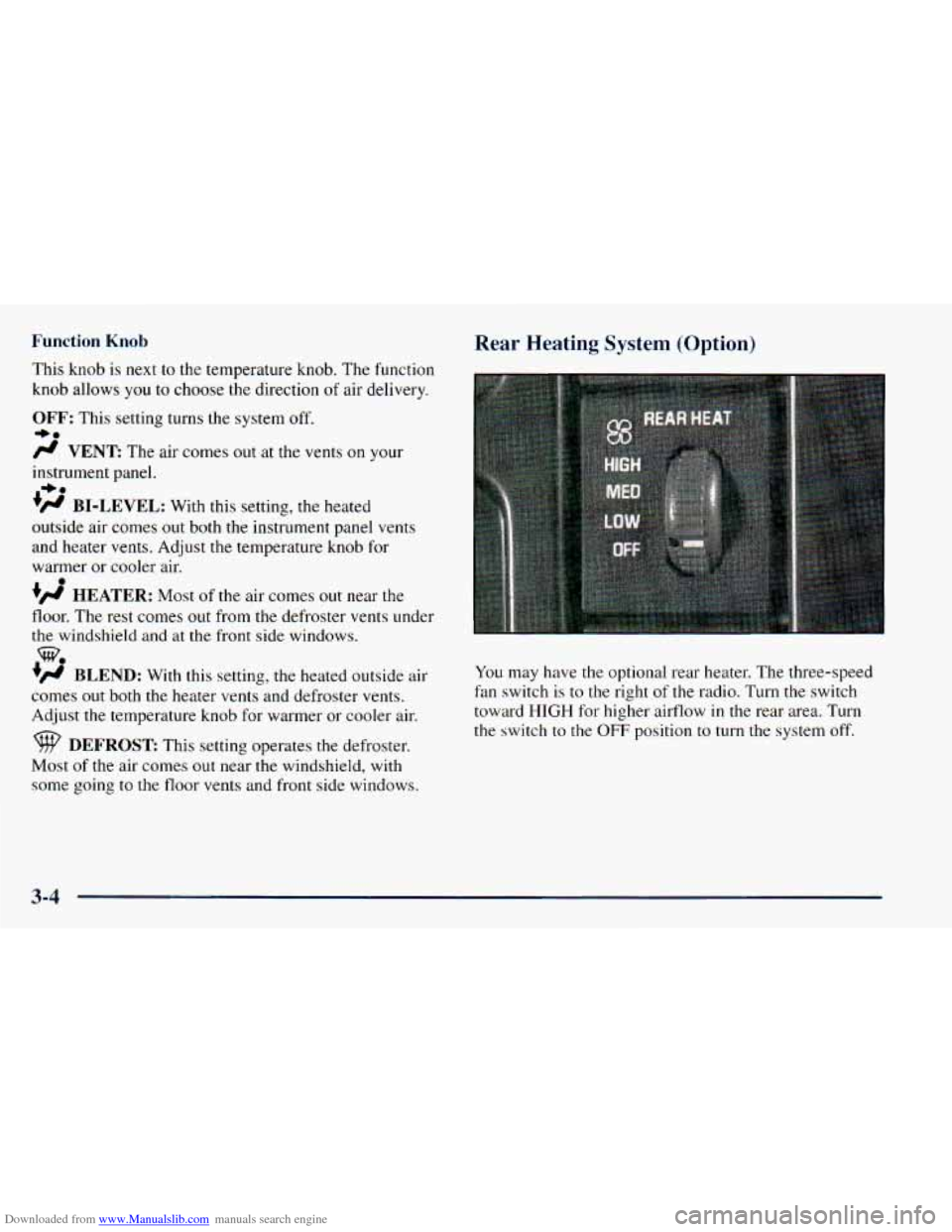
Downloaded from www.Manualslib.com manuals search engine Function Knob
This knob is next to the temperature knob. The function
knob allows you to choose the direction
of air delivery.
OFF: This setting turns the system off.
+*
P@ VENT: The air comes out at the vents on your
instrument panel.
'' BI-LEVEL: With this setting, the heated
outside air comes
out both the instrument panel vents
and heater vents. Adjust the temperature knob for
warmer or cooler air.
+P@ HEATER: Most of the air comes out near the
floor. The rest comes out from
the defroster vents under
the windshield and at the front side windows.
+d BLEND: With this setting, the heated outside air
comes out both the heater vents and defroster vents,
Adjust
the temperature knob for warmer or cooler air.
+e
0
DEFROST This setting operates the defroster.
Most of the air comes
out near the windshield, with
some going
to the floor vents and front side windows.
Rear Heating System (Option)
You may have the optional rear heater. The three-speed
fan switch is to the right
of the radio. Turn the switch
toward
HIGH for higher airflow in the rear area. Turn
the switch to the
OFF position to turn the system off.
3-4
Page 157 of 414
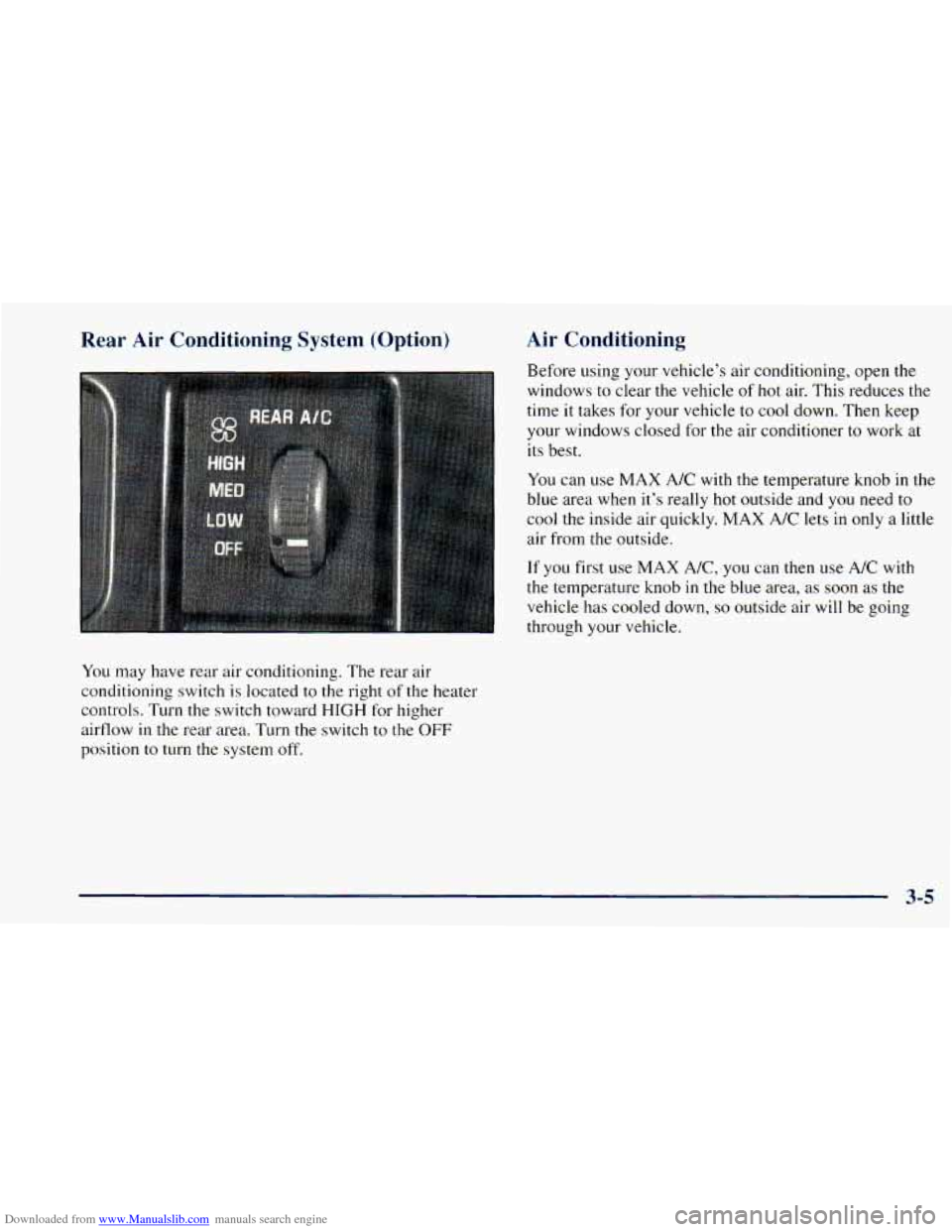
Downloaded from www.Manualslib.com manuals search engine Rear Air Conditioning System (Option) Air Conditioning
Before using
your vehicle’s air conditioning, open the
windows to clear the vehicle
of hot air. This reduces the
time
it takes for your vehicle to cool down. Then keep
your windows closed for the air conditioner to work at
its best.
You can use
MAX A/C with the temperature knob in the
blue area when it’s really
hot outside and you need to
cool the inside air quickly.
MAX A/C lets in only a little
air from the outside.
If you first
use MAX A/C, you can then use A/C with
the temperature knob
in the blue area, as soon as the
vehicle has cooled down,
so outside air will be going
through your vehicle.
You may have rear air conditioning. The rear air
conditioning switch is located
to the right of the heater
controls. Turn the switch toward
HIGH for higher
airflow in the rear area. Turn the switch to the
OFF
position to turn the system off.
3-5
Page 158 of 414
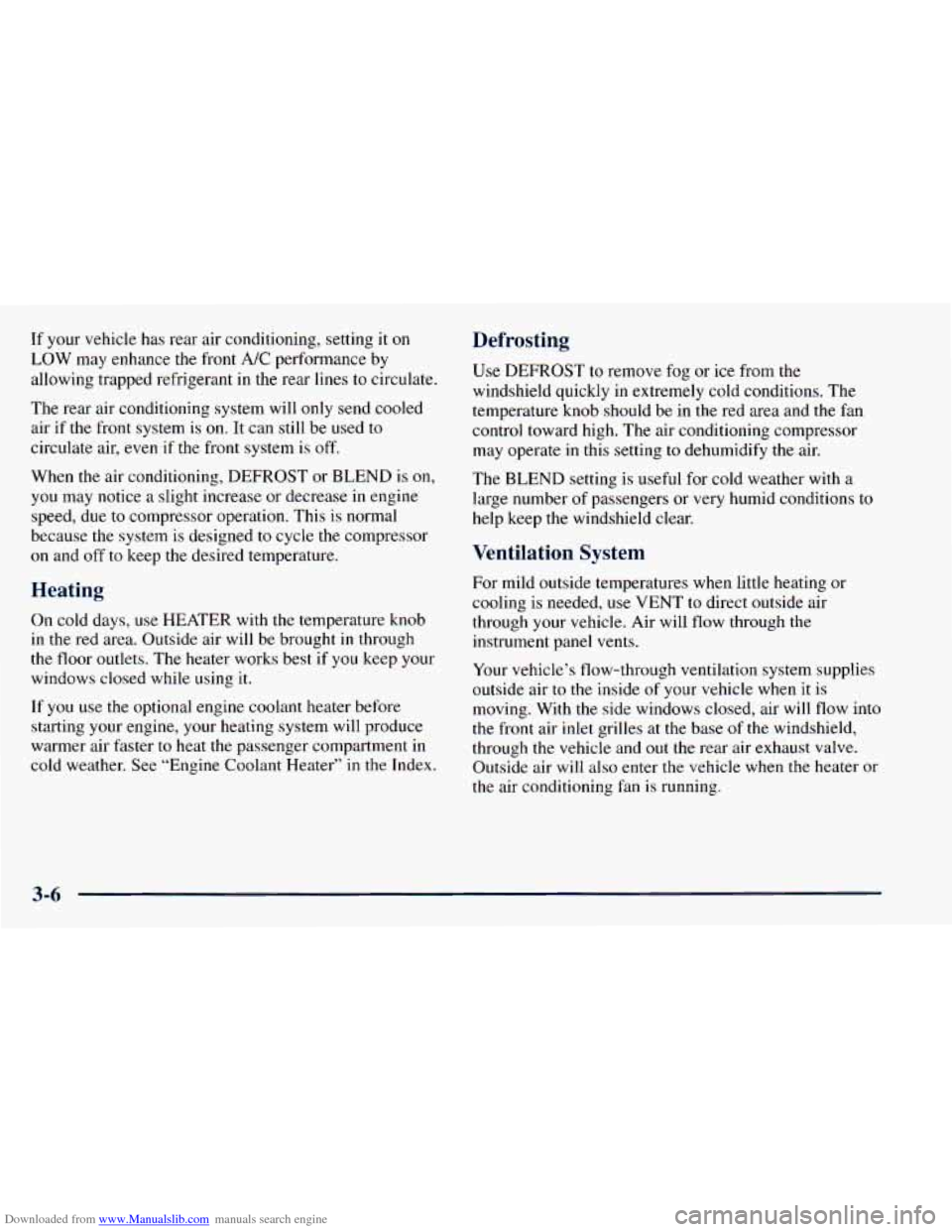
Downloaded from www.Manualslib.com manuals search engine If your vehicle has rear air conditioning, setting it on
LOW may enhance the front
A/C performance by
allowing trapped refrigerant in
the rear lines to circulate.
The rear air conditioning system will
only send cooled
air if the front system is
on. It can still be used to
circulate air,
even if the front system is off.
When the air conditioning, DEFROST or BLEND is on,
you may notice a slight increase or decrease in engine
speed, due to compressor operation. This is normal
because the system is designed
to cycle the compressor
on and off to keep the desired temperature.
Heating
On cold days, use HEATER with the temperature knob
in the red area. Outside air will be brought in through
the floor outlets. The heater works best if you keep your
windows closed while using it.
If you use the optional engine coolant heater before
starting your engine, your heating system
will produce
warmer air faster
to heat the passenger compartment in
cold weather. See “Engine Coolant Heater” in the Index.
Defrosting
Use DEFROST to remove fog or ice from the
windshield quickly in extremely cold conditions. The
temperature knob should be in the red area and the fan
control toward high. The air conditioning compressor
may operate
in this setting to dehumidify the air.
The BLEND setting is useful for cold weather with
a
large number of passengers or very humid conditions to
help keep the windshield clear.
Ventilation System
For mild outside temperatures when little heating or
cooling is needed, use VENT
to direct outside air
through your vehicle. Air will flow through the
instrument panel vents.
Your vehicle’s flow-through ventilation system supplies
outside air to the inside of your vehicle when it is
moving. With the side windows closed, air will flow into
the front air inlet grilles at the base of the windshield,
through the vehicle and
out the rear air exhaust valve.
Outside air will also
enter the vehicle when the heater or
the air conditioning fan is running.
3-6